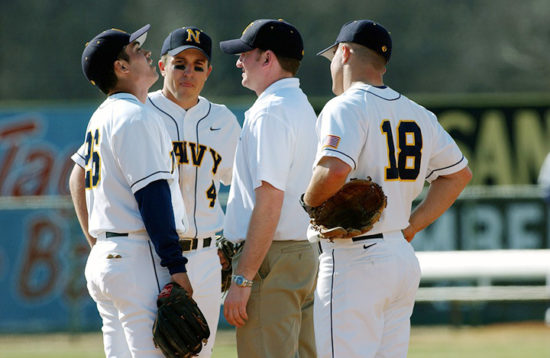The trainer-physician relationship
Working together ensures that athletes are getting the best care
The fact that we have become an increasing litigious society is difficult to argue against or ignore. In the arena of athletic medicine, the number of lawsuits has grown exponentially. Athletic programs and sport organizations have responded to this trend through implementation of risk management strategies, which include such measures as rule changes, education, adoption of new policies and procedures, and hiring an athletic trainer (AT).
 The current public discussion about sport-related concussions has initiated changes in their medical management from the secondary school level to the professional sport level. There is no question that the NCAA is concerned about the health and well being of collegiate student-athletes, which is evidenced by the hiring of its first chief medical officer in January 2013. According to the NCAA, this physician will “lead a new Center of Excellence, which will serve as a national resource for sport safety, health and medical expertise.”1
The current public discussion about sport-related concussions has initiated changes in their medical management from the secondary school level to the professional sport level. There is no question that the NCAA is concerned about the health and well being of collegiate student-athletes, which is evidenced by the hiring of its first chief medical officer in January 2013. According to the NCAA, this physician will “lead a new Center of Excellence, which will serve as a national resource for sport safety, health and medical expertise.”1
There are more than 40,000 U.S. public and private high schools and only about 42 percent of these have “access” to an AT.2 Administrators and coaches in athletic programs that do not have an AT can only hope that a catastrophic injury event does not occur.
Simply hiring an AT (or contracting with an organization for acquisition of AT services) does not automatically reduce the school’s legal liability. Both state medical practice regulations and Board of Certification (BOC) Standards of Professional Practice mandate that the AT provide all services under the direction of a physician. Unfortunately, the nature of the AT-physician working relationship is very poorly defined in many instances, which has led to a widespread misunderstanding about the manner in which the medical chain of command should be structured. Failure to appreciate the importance of a clearly delineated AT-physician working relationship is very risky business, as can be seen in the following example.
During the pre-participation physical examination, a college freshman football player reports that he experienced multiple concussions when playing football in high school. Upon questioning, he indicates that a physician never evaluated him, but that the AT at the high school evaluated his condition. This is a clear example of an AT functioning in an autonomous manner, which could have devastating consequences.
Several questions need to be asked. First, did the athletic program personnel and school administrators believe that autonomous management of the athlete’s condition by an AT was appropriate? Second, were they unaware of the legal obligation for an AT to function under the direction of a designated physician? Finally, was the AT more concerned about upsetting or disappointing coaches, fans or the injured athlete than acting in the role of the medical professional who is responsible for the athlete-patient’s best interests?
Clearly, the availability of an AT and the designation of a team physician do not automatically result in optimal care for athletes when the AT-physician working relationship is poorly defined. The AT is a health care professional who does not require a physician’s presence to provide services, but documented physician authorization of specific procedures and close communication are absolutely essential. A vaguely defined and an indirect relationship of an AT to a team physician, combined with a clearly defined and direct employment or contractual relationship to an athletic program, presents the potential for very serious conflict of interests and legal liability.
 Risk management strategies should include a critical review of the manner in which athletic medical services are coordinated and provided. An editorial that was recently published in the International Journal of Athletic Therapy and Training3 provided the following 10 principles to guide the administration of sports medicine-athletic training services:
Risk management strategies should include a critical review of the manner in which athletic medical services are coordinated and provided. An editorial that was recently published in the International Journal of Athletic Therapy and Training3 provided the following 10 principles to guide the administration of sports medicine-athletic training services:
1. The physical and psychosocial welfare of the individual athlete-patient must always be the highest priority of the athletic trainer and the team physician.
2. Any program that delivers athletic training services, including “outreach” services provided to high schools or other athletic organizations, must always have a designated medical director.
3. Sports medicine physicians and athletic trainers must always practice in a manner that integrates the best current research evidence with the preferences and values of each athlete-patient.
4. The clinical responsibilities of an athletic trainer must always be performed in a manner that is consistent with the written or verbal instructions of a physician or standing orders and clinical management protocols that are approved by a program’s designated medical director.
5. Decisions that affect the current or future health status of an athlete-patient who has an injury or illness must only be made by a properly credentialed health professional (e.g., a physician or an athletic trainer who has a physician’s authorization to make the decision).
6. In every case that a physician has granted an athletic trainer the discretion to make decisions relating to an individual athlete’s injury management or sport participation status, all aspects of the care process and changes in the patient’s disposition must be thoroughly documented.
7. To minimize the potential for occurrence of a catastrophic event or development of a disabling condition, coaches must not be allowed to impose demands that are inconsistent with guidelines and recommendations established by sports medicine-athletic training professional organizations.
8. An inherent conflict of interests exists when an athletic trainer’s role delineation and employment status are primarily determined by coaches or athletic program administrators, which should be avoided through a formal administrative role for a physician who provides medical direction.
9. An athletic trainer’s professional qualifications and performance evaluations must not be primarily judged by administrative personnel who lack healthcare expertise, particularly in the context of hiring, promotion and termination decisions.
10. Universities, colleges and high schools should adopt an administrative structure for delivery of integrated sports medicine and athletic training services to minimize the potential for any conflict of interests that could adversely affect the health and well being of student-athletes.
The International Federation of Sports Medicine Code of Ethics4 states that physicians should “always make the health of the athlete a priority; never do harm; and never impose authority in a way that impinges on the individual right of the athlete to make his/her own decisions.”
These principles should be embraced by all individuals who have a responsibility for student-athlete welfare. Simply using athletes as the means to win games is unethical and unacceptable. What can you do to be an advocate for the health and safety of your athletes?
References
- http://www.ncaa.com/news/ncaa/article/2012-06-20/ncaa-hire-chief-medical-officer; accessed 1/31/12.
- Prentice WE. Focusing the direction of our profession: athletic trainers in America’s health care system. J Athl Train. 2013;48(1):7-8.
- Wilkerson GB. Patient-centered care and conflict of interests in sports medicine-athletic training. Int J Athl Ther Train. 2012;17(4):1-3.
- http://www.fims.org/en/general/code-of-ethics/accessed 1/31/12.





